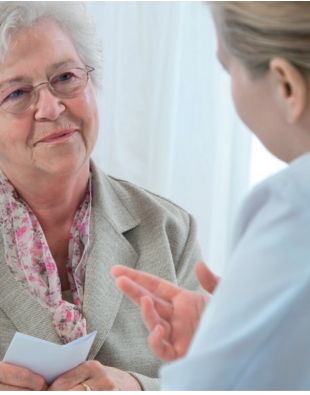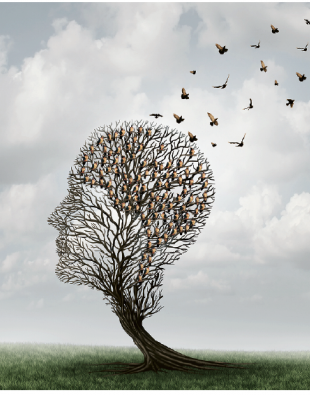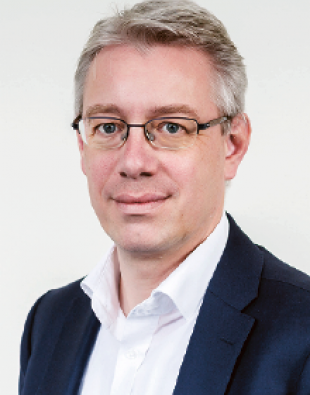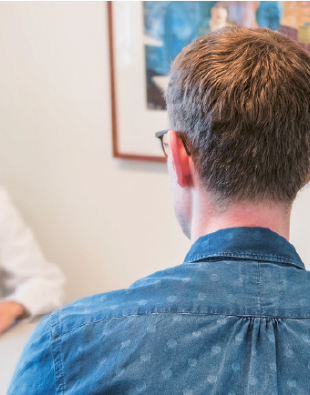
“A good relationship with the patient can achieve more than a drug can”
Oct. 2018Communication in the health sector
Spezialistin. Communication between health professionals and their patients is an important basis for successful treatment. Particularly in the field of health promotion and disease prevention, the right kind of communication can be a decisive factor in bringing about change. Sabina Hunziker, Professor of Medical Communication at Basel’s University Hospital, therefore attaches great importance to the initial and continuing training of professionals.
What constitutes a good patient-doctor conversation?
The hallmarks of a good conversation are when both participants can make their points, pursue the same goal and ultimately adopt a common approach.
What makes for a poor patient- doctor relationship?
When the participants talk at cross purposes, when there are misunderstandings and when anxieties and problems are not addressed. For instance, when the patient talks about their anxieties and the doctor only wants to communicate knowledge.
What types of conversation are there?
There are, for instance, the doctor-centred and the patient-centred conversation. When, let’s say, the patient com- plainsofnon-specificsymptomsandthe medical professional does not yet know what the problem is, it makes sense to conduct a patient-centred conversation. In other words, the professional lets the patient do the talking. They wait, and ask open-ended questions. When it becomes clearer what the problem is, then the doctor-centred model is applied. The professional takes the lead in the conversation and tries to narrow down the problem with specific questions. Depending on the situation, it is possible to switch back and forth between the two types of conversation.
How has communication in the healthcare sector changed over the last few years?
Above all, the roles have changed significantly in the last ten years. Nowadays, good health professionals not only need to have a great deal of knowledge, they must also be able to explain it to the patient in an understandable way. The significance of the patient conversation has grown and is now, in my view, just as important as specialist medical knowledge. A good relationship with the patient can achieve more than a drug. Trust increases personal responsibility and self-management in patients.
What about the patient’s role?
The role of the patient has also changed: above all, younger people have more self-confidence; they don’t simply accept the professionals’ judgement and are more likely to obtain a second opinion. Younger people are also more likely to seek information on the Internet before going to see a doctor, and so they come to the conversation with a degree of prior knowledge, which can also make it quite difficult for the doctor. Patients sometimes request a specific kind of treatment. The doctor cannot simply brush these wishes and prior knowledge aside. They have to address them first, and only then can they discuss alternatives.
How are decisions between health professionals and patients made today?
Here, too, a great deal has changed. It used to be the doctor who decided what was good for the patient. There was less of a discussion. Nowadays, patients are often more involved in the decisions, for instance in situations in which more than one treatment option is available, where there is a state of “equipoise”. In such cases, the doctor informs the patient about the different treatment options and explains their pros and cons. Then a decision is reached jointly. Communication research shows that this model results in more successful treatment in such cases. There are situations in which joint decision-making is very important, for instance when decisions have to be taken at the end of a patient’s life or when treatment has to be broken off. Here, family members often have to be drawn into the decision-making process, functioning as “surrogate deciders” in helping to implement the will of the patient. But these conversations are also very important for the family members themselves and can have a considerable influence on how they cope with the event at the psychosocial level.
How important is joint decision-making in the areaof disease prevention and health promotion?
It’s also very important in this area. Take, for example, a patient with “mild” hypertension. The doctor can discuss two options with the patient: a change in lifestyle, which is often not easy to achieve, or regular medication, which can have adverse reactions. The doctor and patient make a joint decision on the preferred option. Here the doctor functions more as an advisor, presenting the pros and cons. A joint decision significantly increases the chances of the patient actually taking the medicine or changing his lifestyle. But it’s also obvious that high blood pressure cannot be eliminated with a single conversation.
Are there other ways of persuading people to adopt a healthier lifestyle?
Another approach is that of “motivational interviewing”. This approach is adopted, for instance, with patients who have higher levels of tobacco and alcohol consumption. It’s a not exactly easy technique that aims to find out where the patient stands. Have they tried many different approaches to quit smoking? And if so, which ones? Which ones have worked? What resources does the patient have? Where is their motivation for change? It’s important that the doctor and patient can speak to each other on a basis of trust and develop a joint strategy. The health professional must engage very specifically with the patient, listening closely to what they have to say and trying to promote motivation and confidence. What “door” opens up in the course of the conversation? When a “door” opens for a treatment approach, the health professional can latch on to it and draw up a joint plan for achieving change.
Sabina Hunziker
Sabina Hunziker is Professor and Deputy Chief Physician for Psychosomatic Medicine and Medical Communication at the University of Basel. She works in the fields of teaching, research and clinical activities. Born in Basel in 1973, Professor Hunziker studied medicine at the University of Basel and obtained her doctorate in 2005. Following a spell as assistant physician, she worked as a senior physician in internal medicine and intensive care. Graduating with a Master of Public Health after a two-year course of study at Harvard Medical School in Boston (USA), she subsequently pursued studies in psychosomatic and psychosocial medicine. She qualified as senior lecturer in 2012. Sabina Hunziker is married with a son and daughter.
What about the error management culture?
When medical errors occur, there is usually also a connection with communication. As yet, however, little scientific work has been carried out on this topic. There are therefore few figures available to suggest how often medical errors actually represent a communication problem. The focus here is on two questions in particular. How can we avoid errors? And what happens when an error occurs? With regard to the first question, we need, for instance, more people to “speak up”,i.e. people who feel confident enough to raise the subject of mistakes. In many cases, someone may notice that an intervention is not being conducted entirely properly or that one swab is missing after an operation. But they do not feel confident enough to draw attention to these errors. Nevertheless, it is important that they speak out. This can also be done in a friendly way. “Speaking up” can be trained and practised. Improving the error management culture is important because of the need to ensure patient safety.
Checklists can also help to reduce errors. But a checklist alone is not enough. It very much depends on someone know- ing how to use the checklist. This is particularly important in stress situations.
What happens when an error occurs?
Of course, there needs to be communication with the person affected. It is important that the mistake be discussed and the person concerned informed without delay, and that questions and/or reproaches are addressed. But communication with the doctors is also important, because they have made a mistake and they have to handle it. This is not usually dealt with in a standardised fashion. The strategies for handling errors vary according to the hospital or department involved.
How important is non-verbal communication?
It’s certainly important, but unfortunately there have been few good studies that investigated its efficacy. What a health professional says and how they underpin it with non-verbal gestures are important indicators for the patient. For example, a patient is waiting to hear a diagnosis, expecting it to be bad. The doctor enters the waiting-room with a morose facial expression, as under stress. The patient is immediately certain of bad news coming up. Other inappropriate behaviour includes laughing gaily with the patient or making cheerful conversation about unimportant things before then announcing bad news. Eye contact is a very important part of non-verbal communication. When the doctor has, for instance, to communicate bad news to a patient, the initial shock always causes the patient to look away. Only once the patient resumes eye contact with the doctor can they take in additional information.
Health professionals havea great deal of responsibility in this area.
Absolutely. What they say can remain engraved in the memory for a very long time. Some patients remember things said to them by health professionals for the rest of their lives. The health professionals themselves can therefore be expected to give some thought as to how these things are best said.
All these techniques require sound education and regular training. What sort of training do today’s health professionals receive in this area?
At the University of Basel we have what is known as a “longitudinal curriculum” for medical communication. This means that, throughout their entire studies, students attend a structured series of appropriate courses and lectures during which both practical and theoretical knowledge is imparted. The programme comprises tutorials, courses and small work groups. We also work with videos and simulation patients.
The patient simulator is an important training tool: for instance, it enables students to use a manikin on which to practise the right steps for resuscitating patients in cardiac arrest and to improve their teamwork. This approach has demonstrated the great importance of leadership communication in the team when performing resuscitation.
Was ist bei der interkulturellen Komminikation besonders?
Auch wenn Menschen unterschiedlicher Herkunft miteinander sprechen, ist es immer noch ein Gespräch; es gelten also nicht grundsätzlich andere Regeln. Allerdings gilt es einige Ausnahmen und spezielle Voraussetzungen zu beachten. Zum Beispiel, wenn ein Arzt einer Patientin nicht in die Augen schauen darf. Schwierig kann es auch bei Entschei- dungen werden, die in anderen Ländern anders gehandhabt werden, etwa Entscheidungen am Lebensende. Wenn der Arzt vorschlägt, die Therapie abzubrechen und die Geräte abzustellen, und die Angehörigen das nicht akzeptieren. Hier ist ebenfalls wichtig, die Personen in die Entscheide einzubeziehen. Die Entscheidung über Leben und Tod braucht eine gemeinsame Grundlage.
Beispiel eines unglücklichen Dialogs
Patient: Ich habe Angst, dass ich einen Herzinfarkt erleide, ich
habe Schmerzen in der Brust, und es gab auch schon ähnliche Fälle von Herzinfarkt in unserer Familie.
Arzt: Die Befunde sind unauffällig, es liegt kein Herzinfarkt
vor.
Patient:
Ich
habe aber diese Schmerzen.
Arzt:
Machen
Sie sich keine Sorgen. Wir haben einen Herzinfarkt klinisch, im EKG und
laborchemisch ausgeschlossen.
Patient:
Vielleicht stimmt etwas nicht mit diesen Untersuchungen ...
Die Gesundheitsfachleute tragen hier auch eine grosse Verantwortung.
Absolut. Die Sätze, die sie sagen, können sehr lange haften bleiben. Gewisse Patienten erinnern sich ihr Leben lang an bestimmte Sätze, die ihnen die Fachperson gesagt hat. Da darf man erwarten, dass sich die Fachperson auch einige Gedanken dazu macht, wie sie es sagt.




